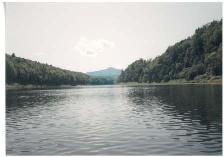|
-- Where is groundwater found?
-- What does the map show?
-- Why is groundwater important?
-- What threatens groundwater quality?
-- Setting Priorities -- What's Next?
Where is groundwater found?:
Groundwater is found within the cracks in bedrock or the spaces between particles of soil and rocks in a saturated zone. Rain and melting snow percolate downward into this zone as groundwater recharge.
Aquifers are sites that have suitable water quality, storage and recharge capabilities to serve as public water supplies. Most of New Hampshire’s reliable aquifer sites are found in deep, coarse grained, stratified drift deposits (sand and gravel deposits).
There are two types of aquifers, unconsolidated glacial deposits, and crystalline bedrock. Unconsolidated glacial deposits, made up of sand and gravel, both store and transmit large quantities of water, and form the most productive aquifers in New Hampshire. The unconsolidated aquifer of sand or gravel is commonly capable of yielding more than 200 gallons per minute. The water level in a stratified drift aquifer can usually be found at between 40' to 80' beneath the surface, but can exceed 100' in gravel, sand, silt and clay deposits, common to valley bottoms.
The crystalline bedrock aquifer is a complex of igneous and metamorphic rock that contains economic yields of water only in open fractures. Wells that penetrate bedrock commonly yield dependable supplies of water suitable for single-family domestic needs. For this reason, bedrock is the principal aquifer for domestic wells. These generally range in depth of 100' to 600' and yield around 10 gallons per minute or less.
What does the map show?:
USGS Groundwater Availability maps were completed in the mid 1970’s. These maps have been entered into the GRANIT GIS at an original map scale of 1:125,000.
Aquifer delineation studies have been completed for the town of Plainfield. The project is a cooperative effort of the NH Water Resource Division (WRD) and US Geological Survey (USGS). The Groundwater map (350kb) includes Plainfield’s aquifers, public well sites, salt storage sites, and gravel pits.
Why is groundwater important?:
Groundwater is the source of water for wells and springs. More than fifty percent of New Hampshire’s population depends on groundwater supplies for drinking water. All Plainfield residents, even those who are served by community water systems, rely on groundwater for drinking. According to the 1990 U.S. Census, only 26 households in Plainfield take drinking water from a source other than a community water system or private well. Thus, while over 750 households tap into a groundwater source, very little is known about aquifers in Town. If water is pumped from an aquifer more quickly than it is recharged, users may experience a dry well.
What threatens groundwater quality?:
Pollution threats to water quality include septic systems, salted roads and uncovered salt piles, leaky underground storage tanks, industrial sites, waste disposal facilities, agricultural land, and highways. Underground storage tanks are now recognized as serious threats to groundwater quality. Research has shown it is not uncommon for underground tanks to develop leaks. Given New England's acidic soils and rain, most tanks over 15 years old are expected to have leaks. Unfortunately, toxic substances, such as gasoline and fuel, are commonly stored in underground tanks. State regulation of tanks with volumes larger than 1,100 gallons has been adopted. New tanks have to meet strict design standards and all tanks are subject to regular testing. Regulation of tanks with volumes less than 1,100 gallons is left to localities so most residential storage tanks are not monitored by the State.
Setting priorities – what’s next?:
- The Plainfield Master Plan recommends that, “An in-depth study of Plainfield's aquifers should be undertaken to identify recharge areas, aquifer and subsurface movement of water...”
- Examine our zoning and building regulations to determine if they adequately protect our groundwater resources.
- Educate residents and businesses about the proper disposal of hazardous wastes as an important safeguard against water contamination.
- The Town should continue to promote regional hazardous waste collections and encourage residents and businesses to participate.
|



